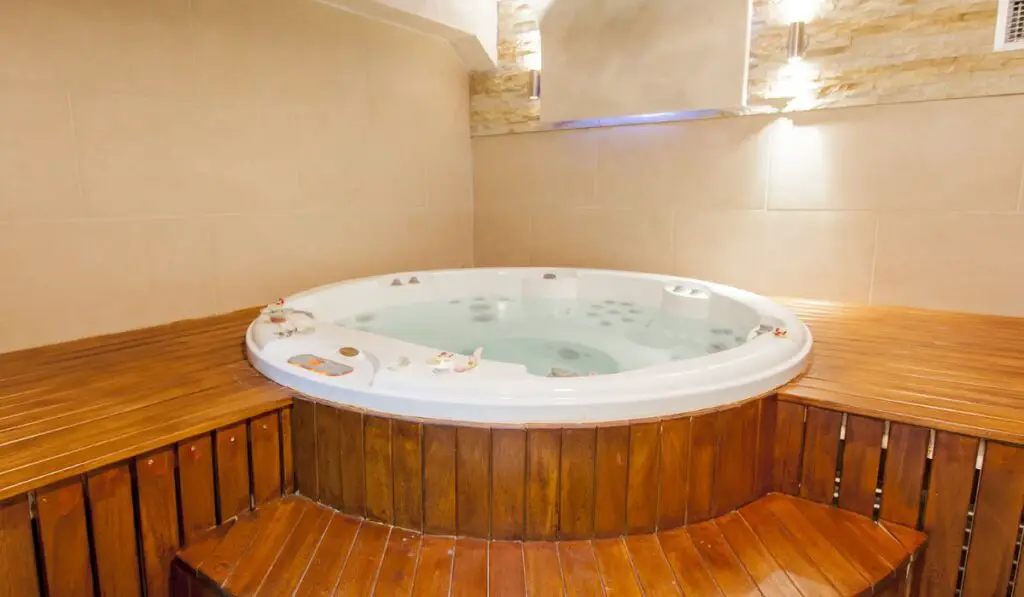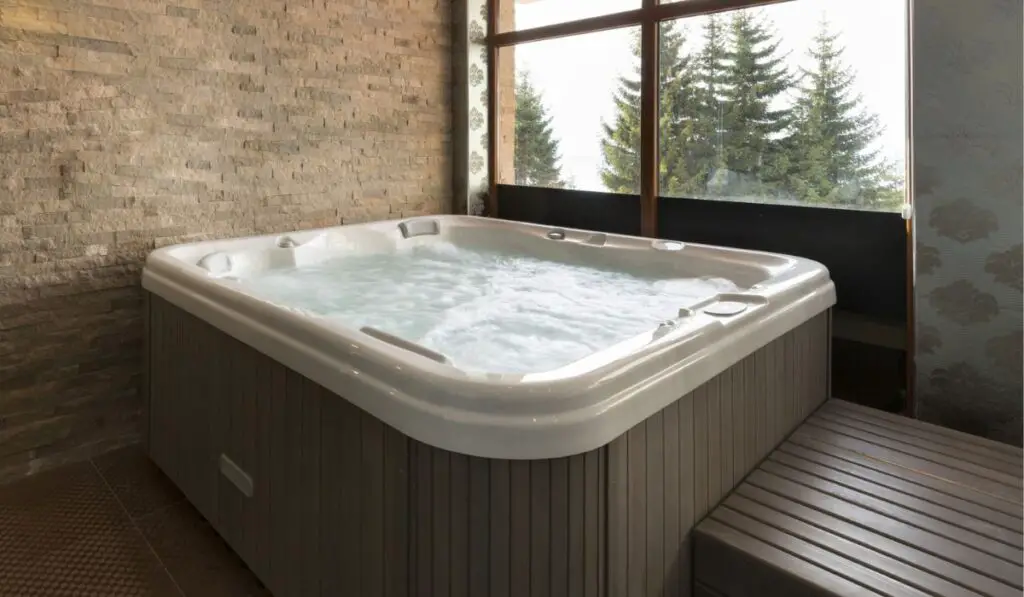Having a hot tub indoors is a luxury that many people have considered. However, it can be a great advantage to have a fully working hot tub to soak in just down the hall, from privacy to convenience to year-round use. For these reasons, it has become very popular among homeowners to invest in such an endeavor.
To have an indoor hot tub, you must consider ventilation, floor reinforcement, waterproofing the walls and floor, and utility access. A number of problems can arise, such as strong odors, high costs, ventilation issues, and humidity issues.
Many people underestimate what is actually needed, from waterproofing to ventilation, and many have suffered the consequences that have put them back thousands of dollars in repairs. Avoiding these issues is simply educating yourself on the proper process of installing a hot tub indoors.
Do Hot Tubs Have to Be Outside?
Hot tubs don’t just have to be outside. Inside they can provide you with optimal privacy in a controlled environment that isn’t dependent on the weather for use. So no matter the time of day or the weather outside, a hot tub can still be utilized indoors, all year round.
What to Know About Indoor Hot Tubs

There are a few things that need to be considered about the hot tub before planning to install it indoors.
- Typically, a hot tub with less water volume, meaning a small to a medium-sized hot tub, is better suited indoors.
- There is also the restriction of getting it into the house, which can be hampered by the width of doors or windows.
- 120-volt hot tubs are a lot easier to install since they have a plug-and-play nature that doesn’t require any hard wiring and electrical adjustments.
With a few considerations on the type of hot tub and the room itself, you can safely put a hot tub indoors and enjoy it whenever you want.
Is it Okay to Put a Hot Tub Inside?
When placing a hot tub indoors, there are a few concerns that need to be thought about. The first is how the hot tub will fit and what room it will go into.
The Water
You want to ensure any spillage or overflow of water won’t damage the floors and no one will slip getting in or out of the hot tub.
You need to consider how you will fill the hot tub since most of the time, when a hot tub is outside, a hose is run to the spa and filled that way. Being inside makes it a little more tricky.
The Walls
There are the actual walls to consider, too, since the humidity and condensation will cause problems as time passes, such as mold and bubbling drywall. Proper ventilation is key to avoiding issues that could amass thousands of dollars in repair.
The Weight
The weight of the hot tub also needs to be thought about since second or third stories are not designed to carry thousands of weight in a small localized area. Even basement floors should be looked at to support that kind of weight or risk damaging the flooring.
There are many things to consider when placing a hot tub indoors, and it’s a careful balance to avoid future problems within your home, but it can be done.
Hot Tubs Indoor Problems

Like with any high-ticket item, some issues can arise at future dates, from electrical issues to repairs. However, with a hot tub indoors, some unique problems can develop from having that kind of water and humidity in a localized area. Avoiding these issues is key to enjoying your indoor hot tub for years to come.
Chemical Odors
Chlorine has a strong smell, and hot tubs utilize this chemical in the water chemistry to maintain a hot tub and as a cleaning agent.
However, sanitizing the hot tub requires heavy-duty chemicals that can have harsh smells lingering in an enclosed environment for an extended period. Not to mention the smell of the water itself tends to give off a strong chlorine smell.
High Installation Costs
A hot tub is expensive, but having one installed indoors could raise the cost by a few thousand dollars. You need to prepare the space for a hot tub, including the walls, flooring, ventilation, and proper utility access.
The movers will most likely charge a premium due to the need to navigate through doors or windows, which generally counts as a difficult installation.
There is the house structural work of reinforcing the floors as well as concrete work if the ground floor isn’t already prepared. A waterproof, non-slip floor covering is needed around the hot tub to prevent damage or accidents.
Ventilation and Humidity
Hot tubs come with a lot of humidity from their higher temperatures and abundance of water. Being indoors and in an enclosed space can cause issues associated with this to increase tenfold.
To avoid mold and mildew issues, the room will need to be outfitted with an extractor fan to push the moisture outside.
Another helpful appliance to have is a dehumidifier (on Amazon). It will help control the humidity, and they come in different sizes based on the square footage of the room it will cover.
Installing moisture-proof drywall can go a long way in preventing moisture damage or waterproofing the existing drywall to prevent the growth of mold, mildew, and water damage.
Floor Reinforcement
A house building code for the upper floors requires it to support 40 to 50 lb per square foot. However, a hot tub requires 100 lb per square foot, making the need to reinforce floors almost a requirement should you be looking to place your hot tub on any level other than the basement.
Flooring
You might think that the type of floor doesn’t matter, as long as it is sturdy and flat, but that isn’t entirely true. You need to pick a floor that can withstand regular splashes and water dripping, as mold and mildew build-up will be constant problems otherwise.
A slippery floor is also a safety hazard, which can cause personal injury to hot tub users. Floors like tiles, concrete, and laminate are slipping hazards and bad for mold or mildew growth.
It can be expensive to do the flooring in your hot tub room, and some people have gotten away with simply placing down a bath mat for temporary fixes. However, having proper flooring is vital in the long run to avoid accidents and damage.
Utilities Access
The average hot tub requires a 240-volt circuit, which requires an upgrade from a licensed electrician and sometimes can need the breaker rewired.
However, many people opt for the smaller 110-volt hot tub, which can run on regular house electrical wiring, as the pump doesn’t have to work so hard to heat the water above room temperature.
There is also the need for water access, as typically, a hose is run to an outdoor hot tub to fill it. Being inside, this isn’t always an option. On top of the need to fill the hot tub is a required maintenance task of draining it every 3 to 6 months. This involves attaching a hose to the drain plug and having somewhere to direct the water.
You will need a convenient location within your home for both water and electrical access to avoid utility and maintenance issues down the line.
How Do You Take Care of an Indoor Hot Tub?
Once the room is prepared correctly, it is easy to maintain the indoor hot tub, similar to having one outdoors.
- Shock and sanitize your water properly with 1.0-4.0ppm of chlorine or 2.0-6.0ppm of bromine.
- Keep the filter clean with regular cleaning.
- Maintain a healthy water balance by keeping the water at 7.2 or 7.8 pH and alkalinity between 80 and 140. You also want calcium hardness between 150 and 250.
- Keep the hot tub covered when not in use to keep debris, pets, and children from accidentally falling in. A cover can also minimize evaporation and maintain water temperature.
- Install a floor drain in the room for easy clean-up and hot tub draining.
- Install a hose spigot in the room for easy filling.
- Have an intact vapor barrier under the wall to help with preventing dry rot in the studs or joists of the wall structure.
- Install a ceiling fan in the room to aid in air circulation.
- Consider a saltwater hot tub since it won’t have the harsh water smell.
